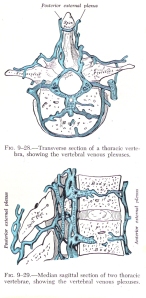The image on the right is an excellent MR venogram of the brain. If you are interested in the names of the veins, just click on the image and you will see the annotations. The largest veins you see are the superior sagittal sinus at the top, the transverse to sigmoid sinuses located along the bottom running somewhat horizontally and then downward from the back toward the front of the skull and finally the internal jugular veins descending straight down the neck.
There is another interesting vein called the straight sinus which takes off at approximately a 45 degree angle forward and upward from the transverse sinus. The straight sinus is pertinent to Dr. Schelling’s research involving the location of the lesions in MS. According to Schelling, one of the key areas that reverse flows, called back jets, vent into is the straight sinus. This explains why lesions tend to show up in areas surrounding tributary veins of the straight sinus. I will discuss more on Schelling’s research about the location of the lesions in future posts.
 The network of much smaller veins below the transverse sinus and behind the internal jugulars, is the vertebral veins, more commonly called the vertebral venous plexus (VVP). A plexus is a network, which is exactly what the VVP is. Although the individual veins may be small, the drainage capacity of the vast network of veins of the VVP located inside the spinal canal and surrounding spine is huge.
The network of much smaller veins below the transverse sinus and behind the internal jugulars, is the vertebral veins, more commonly called the vertebral venous plexus (VVP). A plexus is a network, which is exactly what the VVP is. Although the individual veins may be small, the drainage capacity of the vast network of veins of the VVP located inside the spinal canal and surrounding spine is huge.
Some of the most important extra venous outlets in humans that drain into the cervical VVP are located around the foramen magnum. Some actually pass through it. Another frequently used route is located behind the mastoid bone of the ear. There are many different design variations in the extra venous outlets used by humans for upright posture. Some designs simply work better than others and some are predisposed to drainage issues due to reduced capacity by design.
The image below is of a female with migraine headaches which, interestingly, is sometimes associated with MS. The image on the left taken before a chiropractic upper cervical correction shows significantly more blood flow through the left and right internal jugular veins. Following upper cervical correction flow through the internal jugular veins is considerably reduced and blood flow through the vertebral veins seen in the middle in the area of the foramen magnum is increased.
What’s particularly fascinating about this MR venogram image is that it was done with the patient lying down, when the demands on the VVP are significantly lower. The primary role of the VVP is to drain the brain during upright posture. Even so, it nonetheless appears to play a prominent role in the recumbent position as well.
In this case the sigmoid sinus to internal jugular vein routes were being overburdened due to a venous shift in their direction as a consequence of reduced drainage capacity in the cervical portion of the VVP drainage routes. The reduced drainage capacity of the brain to cervical VVP routes was the result of a chronic upper cervical strain chiropractors call a subluxation. In this case the burden on the jugulars would have further increased significantly during upright posture due to failure of the VVP.
In other words, the cause of the CCSVI in this case was due to back pressure and sluggish circulation in the VVP as a result of an upper cervical subluxation, not faults, such as stenosis in the jugular routes.



That is a great illustration that shows how vascular compromise of the brain can cause subluxation and disease. There is so much related to the vascular component of the VSC. We tend to have blinders on and only look at the neurological component and forget the other underlying pathology.
Hi doctor,
I have been diagnosed as having ms by one neuro and not by another here in Ireland. I have one large and two small lesions in the cervical spine with spondylosis and bony spurs in the cervical spine ( clear brain mris). My symptoms began with serious neck pain. My symptoms are sensory mainly but the burning pain is very severe. I hope you dont mind me e-mailing you to ask if you knew of any specialist or chiro here in Ireland who would be able to investigate. My Neuro warned me against having any chiro work done which is why I wouldn’t go to someone form the golden pages! When I first started researching this, I did some reading on a site from the US which suggested that misalignment could be the cause of some ms and how people improved with adjustments. When I asked my gp he said that bones would not cause this Sept 2008 and I believed him until I saw this site.
thank you for your time and the work you are doing
Regards
Mary